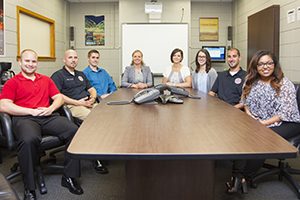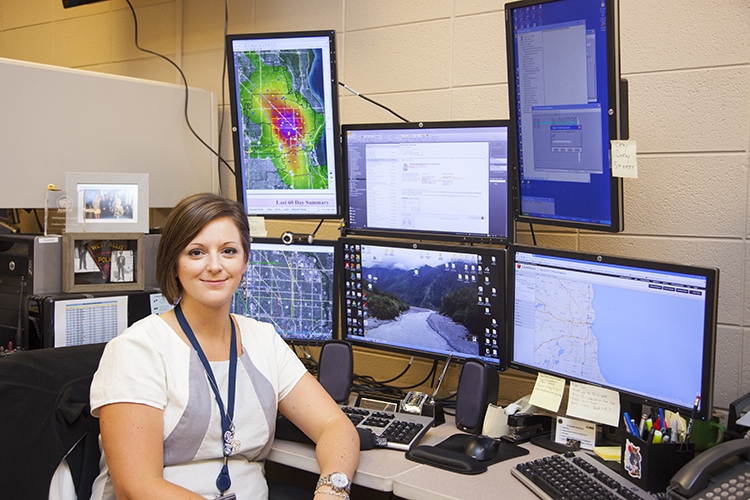UWM alum Stephanie Sikinger doesn’t use traditional tactics to fight crime. Her preferred tools are a computer and a mountain of data.
Sikinger, who completed her bachelor’s degree in criminal justice in 2009 and her master’s in 2011, specializes in the new field of crime analysis.
Crime analysis uses cyber tools such as GIS mapping, data mining and analysis to help gather information on crime, identify and analyze patterns and trends, and plan how to best use resources to prevent and solve crime.
Sikinger is crime and intelligence manager for the Milwaukee Police Department’s Intelligence Fusion Center. The work she and her team do is increasingly important to police departments, here and around the country.
“The Intelligence Fusion Center is an invaluable asset to MPD and the greater Milwaukee community,” Milwaukee Police Chief Edward Flynn said. “Its use of cutting edge technology, strategic data analysis, and collaboration with local, state, and federal law enforcement partners is essential to the safety and security of Milwaukee residents and beyond.”

Crime analysis is a fairly new specialty, and Sikinger didn’t find her path to it directly. Like many college students, she started at UWM not sure of what type of career she wanted. She initially took courses in journalism because she was intrigued by the idea of investigative journalism.
She switched to the criminal justice program and enrolled in what was probably the university’s first crime analysis course as a graduate student. A class trip to the Milwaukee Police Department’s Intelligence Fusion Center opened her eyes to a new career possibility.
“It was like the lightbulb and the epiphany moment… I said, ‘This is it. This is what I want to do.’”
That visit led to a chance to job shadow Nicole DeMotto, the crime analyst she met on the field trip, and eventually a volunteer internship at the center, and then a full-time job.
It’s a growing field, Sikinger said. Just as she benefited from her work at UWM, students from UWM’s program are helping the department. Four recent interns have been hired because their preparation through UWM allows them to hit the ground running, she said. The Intelligence Fusion Center has grown from three analysts when she started four years ago to nine currently. Another analyst is embedded with the Homicide Department, and six or seven more work on long-term strategies with the department’s Office of Management and Planning.
The work of an analyst varies every day, and depends on where he or she is working. The chief or police administration might need information to respond to a media request or do a presentation. Or an officer might want more background on a house at the center of numerous calls in a neighborhood. The tools she and her team use range from geographic information systems to data mining.
This summer, for example, Flynn credited the center’s collaborative work with the federal Bureau of Alcohol, Tobacco, Firearms and Explosives with tracking down the original purchaser of a gun used to shoot a police officer.
The key skill analysts bring is helping the officers sift through mountains of data to find the patterns – and the anomalies. “They can’t just say ‘give me everything you’ve got,’” she said. “We need to work with them to find out what is the problem they’re trying to solve. It’s building a relationship and digging into a question.”
More and more officers are coming to the center for help. Sikinger does training sessions for those interested at the department and at the police academy to show how crime analysis works. Her message: “What I want to do is help you do your job better, more efficiently, to make your life a little easier.”
Some of the work focuses on predictive intelligence, which looks for patterns and tries to prevent the next crime. Outbreaks of burglaries are good examples, according to Sikinger.
“We look at vehicles involved and suspect descriptions or things that were taken and try to see if there are things in common,” Sikinger said. “We try to assist the officers and detectives generate leads and provide actionable intelligence.”
And sometimes, the work can help solve crimes. One case Sikinger particularly remembers involved a serial rapist. Working with officers, she and another analyst started with a nickname and connected it to two investigative leads. Further analysis of the leads revealed a potential suspect and current address in another jurisdiction. They also found he had an outstanding warrant. Officers in that jurisdiction arrested the suspect on that warrant. That allowed them to collect DNA, which, in turn, was linked to several sexual assault cases across multiple jurisdictions.
“It’s a good feeling knowing we helped with that case,” Sikinger said. “That person can no longer harm anybody anymore partly because of the work that we did. That was huge. It was a really good day.”








